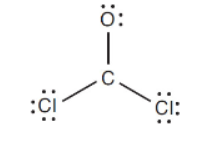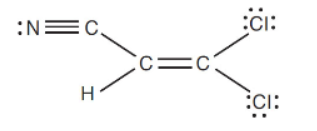Practice Exercises - Covalent Compounds, Formulas, and Structures - AP Chemistry Premium 2024
Multiple-Choice
1. Which of these molecules has a shape related to a tetrahedron (or has sp3 bonding)?
(A) CBr4 and NH3
(B) PF5
(C) NH3 and HCN
(D) SO3
2. Which of these molecules has the largest bond angle?
(A) HCN
(B) PF5
(C) NH3
(D) SO3
3. The observation that the bond lengths found in the nitrate ion are equal is due to
(A) resonance structures
(B) hybridization of the central atom
(C) the presence of ionic bonds
(D) the existence of lone pairs of electrons
4. Which of these molecules have all atoms lying in the same plane?
(A) CBr4 and NH3
(B) PF5
(C) NH3 and HCN
(D) SO3 and HCN
5. Which of the following molecules are paired correctly with their molecular geometry?
(A) PF5, tetrahedron
(B) XeF4, square planar
(C) CCl4, trigonal pyramid
(D) SF6, square pyramid
6. In which of the following are the elements listed in order of increasing electronegativity?
(A) Ba, Zn, C, Cl
(B) N, O, S, Cl
(C) N, P, As, Sb
(D) K, Ba, Si, Ga
7. The difference in bond angles for SBr2, PBr3, and CBr4 is due to
(A) the dissimilarity in bond polarity between the central atom and bromine
(B) the size of the central atom
(C) the presence of several lone pairs of electrons
(D) the variance in bond length and strength
8. Which of the following is a nonpolar molecule containing polar bonds?
(A) H—C≡C—H
(B) H—H
(C) CH4
(D) F—Be—F
9. Which of the following has the fewest pi bonds and is nonpolar?
(A) HCCH
(B) CO2
(C) 
(D) N2
10. The following diagram is an incomplete Lewis structure.

What does the complete Lewis structure for the diagram have?
(A) Both polar and nonpolar bonds
(B) At least one double bond
(C) Resonance forms
(D) At least one lone pair of electrons on each atom
11. Which of the following is NOT a linear structure?
(A) I2
(B) 
(C) CO2
(D) H2S
12. The Lewis structure of the cyanide ion most closely resembles
(A) N2
(B) O2
(C) CO2
(D) NO
13. In which of the following pairs are the two items NOT properly related?
(A) sp3 and 109.5°
(B) Trigonal planar shape and 120°
(C) sp and 180°
(D) Square planar shape and 120°
14. The nitrate ion,  , can be described by the following Lewis structures:
, can be described by the following Lewis structures:

What does this diagram mean?
(A) Two nitrogen to oxygen bonds are single bonds and a third is a double bond.
(B) The nitrate ion can exist as three equal forms in equilibrium.
(C) The nitrate ion exists in one form that is an average of all three structures shown.
(D) The electrons are rapidly exchanged among the three forms.
15. Which of the following has a nonbonding pair of electrons on the central atom?
(A) BCl3
(B) NH3
(C) CCl2Br2
(D) PF5
16. Which of the following is true when the C=C and C≡C bonds are compared?
(A) The triple bond is shorter than the double bond.
(B) The double bond vibrates at a lower frequency than the triple bond.
(C) The double-bond energy is lower than the triple-bond energy.
(D) All of the above are true.
17. Why does a molecule of BF3 have no overall dipole moment but a molecule of PF3 does?
(A) The overall structure of BF3 is linear.
(B) The atomic radius of phosphorus is larger than the atomic radius of boron.
(C) The overall structure of BF3 is trigonal planar.
(D) BF3 does not have a symmetrical structure but PF3 does.
18. There are ___ sigma bonds and ___ pi bonds in the following compound.

(A) 7, 2
(B) 6, 3
(C) 8, 1
(D) 9, 0
19. The molecular shape (geometry) of a Cl2CO molecule is ________.
(A) trigonal planer
(B) tetrahedron pyramidal
(C) trigonal pyramidal
(D) bent
.png)
20. Sulfur forms the following compounds: SO2, SCl2, and . Which form of hybridization is NOT represented by these molecules?
(A) sp
(B) sp2
(C) sp3
(D) None of these
21. Which of the following is least related to the strength of a covalent bond?
(A) vibrational frequency
(B) bond order
(C) bond length
(D) bond direction
Free-Response
Answer the following questions regarding the concepts and properties concerning the structure and geometry of molecular compounds.
(a) Diethyl ether, CH3CH2OCH2CH3, is a highly flammable liquid. It is a common solvent in many laboratories.
(i) Draw the Lewis structure for this compound. Identify the electron pairs and molecular geometry of the oxygen. Explain your response.
(ii) Explain using VSEPR theory why the bond angle for the C–O–C bonds are not at 180°.
(iii) Are there any polar bonds in this molecule? If so, indicate the positive and negative poles of each bond. Is this molecule polar or nonpolar? Defend your answer.
(b) (i) Draw the Lewis structure for nitrogen trichloride, and determine its molecular geometry. Explain what hybrid orbitals are required to produce this structure.
(ii) Based on the structure of nitrogen trichloride, are the bonds in this molecule polar? If so, indicate the positive and negative poles in an appropriate manner. Explain your reasoning.
(iii) As seen in part (i), a molecule of nitrogen trichloride is possible. Is a molecule of nitrogen pentachloride possible? Justify your answer.




